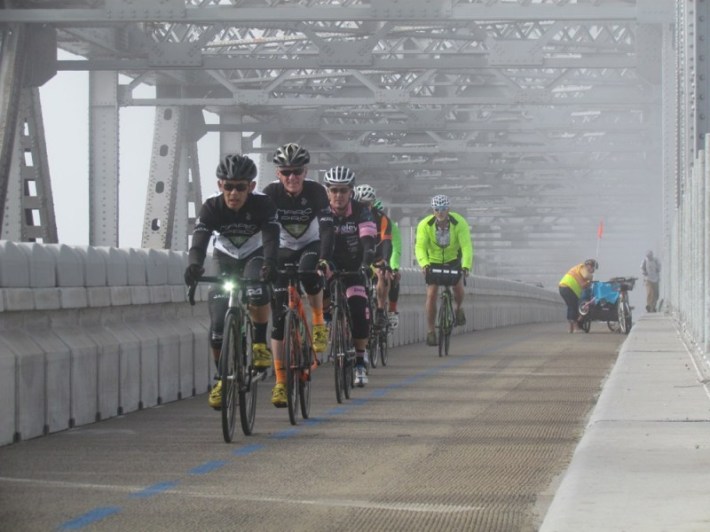It was an eye poke for advocates for safe streets--at the start of the week the San Francisco Chronicle ran a story titled "Bike lane causes traffic misery for teachers on Richmond-San Rafael Bridge." The headline's premise is, of course, absurd to anyone studied in transportation and traffic.
Streetsblog started to write a response on Monday, but the Chron's angle was so ridiculous--and there are so many transportation and safe streets stories to cover--it barely seemed worth the bother. Plus it was inevitable that advocates on social media (as well as other transportation journalists) would be all over the layers of bad logic in the story.
That happened and impressively so. For example, there's the screamingly obvious problem that the only reason teachers are making such long commutes is because there's no place for them to live in Marin, which was given only a passing mention in the Chronicle. Bike East Bay's education director posted this in response:
“More lanes” isn’t going to fix #RSRBridge congestion. So I’m ready to stand with teachers, construction workers, landscapers, and others to demand more housing & affordability in Marin, reducing the need for arduous transbay commutes in the first place. https://t.co/EgcROTRdrd pic.twitter.com/NKkMJp0wNy
— Robert Prinz (@prinzrob) February 3, 2020
Meanwhile, Peter Flax at Bicycling Magazine shredded the Chronicle's framing in "Hey Drivers: Bike Lanes Don’t Cause Traffic Jams," published Wednesday. In it, he points out that the Chron story reads like propaganda supporting "an orchestrated campaign to undermine one of the most well-received new bike lanes in the United States.”
The push to remove the bike path on the bridge is no secret of course. And Marin County Supervisor Damon Connolly, a drunk/hit-and-run driver who sits on transportation policy committees, is proudly leading it. Flax goes on to write that:
Though she name-checks the real problems plaguing miserable commuters, the central premise of her piece lends credibility to the absurd idea that the basic needs of embattled, working-class commuters are being trampled upon by people riding bikes. I presume teachers were picked as the focal point because they seem like sympathetic, unimpeachable victims, but the sources’ off-the-cuff reasons for not commuting by bike themselves (like fear of being mugged while riding an expensive e-bike) are parroted without question. To put a finer point on it, just because a few people don’t see themselves using a bike lane doesn’t demonstrate that the bike lane is a bad idea.

If Streetsblog could add anything, it would be to remind people that the proposal on the table now isn't to turn the bike path back into a car-and-truck breakdown lane--it's to turn it into another motoring lane, at least during rush hour. So if the problem, as described in the Chron's piece, is that car commuters have an unreliable commute because broken-down vehicles have no place to pull over, turning the bike lane into a motor-vehicle travel lane won't solve it.
However, it would be a good rationale for turning the extra eastbound vehicular lane back into a shoulder. It's also an argument for removing traffic lanes from the decks of the Oakland Bay Bridge and the Golden Gate bridge to make breakdown space.
Anyway, enough about the sophistry in the Chronicle's article.
There is an actionable takeaway, however, for advocates to work on: the Bay Trail, which leads to the bike path entrances on both sides of the Richmond-San Rafael Bridge, varies from wonderful to absolute crap. There are still huge gaps in it. As Flax mentioned, the teachers in the story made the excuse that they can't bike to work themselves because the bike approaches are sketchy and dangerous (and in places, that's true, although the danger is less from crime and more from trying to navigate on streets shared with fast-moving cars and trucks, replete with dangerous intersections and freeway ramps.)
John Bauters, the Emeryville politician mentioned in the Chronicle's story (who commutes from Emeryville to San Francisco once a month, by bike, for Bay Area Air Quality Management District meetings), suggested in a phone call with Streetsblog that the story be used to kick off a new initiative to finish and improve the Bay Trail. Marin and Richmond and the other Bay Area counties and cities on routes to the bridge need to add better lighting, better way-finding, and protected bike lanes and intersections all the way.

That's something Bauters said he'll be working on. Because teachers and anybody else who might want to use the bridge should feel safe.
One last thought for the teachers: maybe "induced demand" is a topic they should study and incorporate into their curriculum. Streetsblog would be happy to bike to Marin and help teach it.





